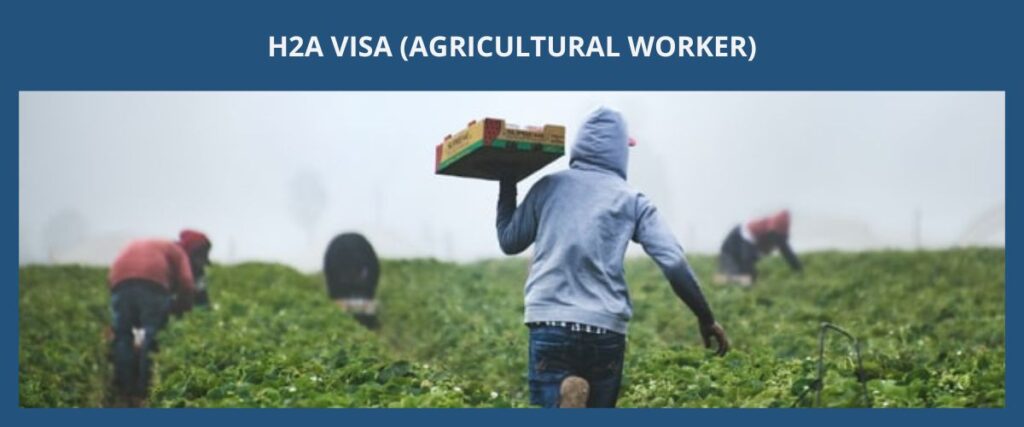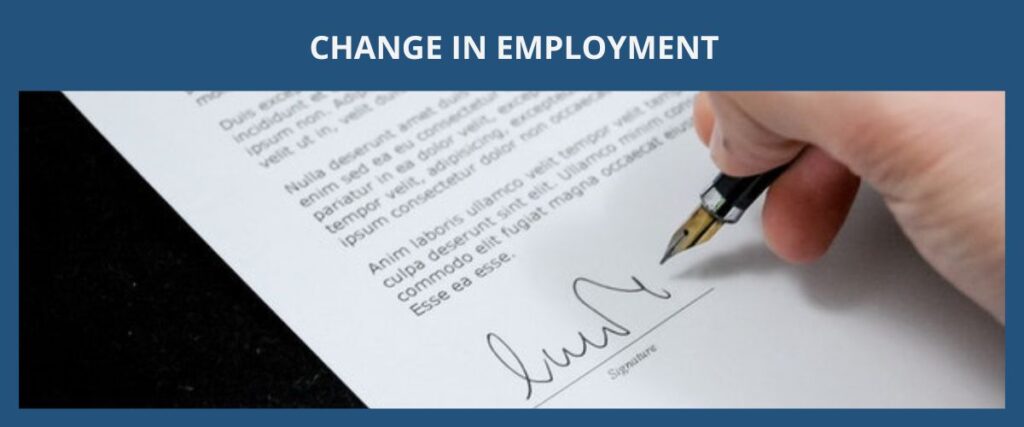The H2A visa is a nonimmigrant (temporary) visa for persons who are citizens from certain foreign countries to work temporary (less than 1 year) or seasonal (tied to a certain time of the year) agricultural jobs in the United States.
- 1.
- 2.
- 3.
- 4.
- 5.
- 6.
- 7.
- 8.
- 9.
- 10.
- a.
- b.
- c.
Table of Contents
Under the H2A visa, the H2A visa worker must be from a national or citizen of certain countries that are participating in the H2A visa program and the H2A visa job must be for agricultural work.
The original statutory wording for qualified persons for H2A visas can be found in 8 CFR 214.2(h)(1)(ii)(C).
Qualified H2A Visa Worker
A qualified person under the H2A visa must (1) have the nationality or citizenship of an H2A visa participating country and (2) have the qualifications (e.g., related work experience) for the H2A visa job position.
Qualified H2A Visa Job Position
A qualified job position under the H2A visa must (1) be for full-time agricultural work, (2) be a temporary or seasonal need for the U.S. sponsoring employer (i.e., the focus is on whether the needs of the U.S. sponsoring employer are temporary or seasonal and not on whether the H2A visa job duties are seasonal), and (3) offer a wage that is the higher of the (a) AEWR (Adverse Effect Wage Rate) wage that is published every year in the Federal Reregister, (b) the collective bargaining agreement rate (CBA rate), (c) state or federal minimum wage, or (d) the prevailing hourly wage or piece rate (AOWL).
Under the H2A visa, a temporary agricultural job is for work that lasts less than 1 year whereas a seasonal agricultural job is tied to a certain time of the year when extra labor is in need (e.g., a short annual growing cycle pattern).
H2A Visa Agricultural Work
The agricultural work under the H2A visa includes but is not limited to:
- Planting
- Cultivating
- Harvesting
- Farming
- Raising livestock
- Forestry and lumbering
- Services and labor in conjunction with or incident to farming operations (e.g., the preparation of the unmanufactured agricultural goods for the market or the delivery to transporting carriers or to storage)
Unmanufactured Agricultural Goods
The planting, handling, packing, drying, packaging, freezing, processing, grading, storing or delivering “unmanufactured” agricultural goods to the storage, market, or carrier of contracted farms can be included as agricultural work under the H2A visa if the farm produced over half of the agricultural goods for the H2A visa worker’s U.S. employer. For example, work that includes peeling, boiling, and packaging fish cannot be qualified as agricultural work under the H2A visa because the agricultural goods (fish) do not remain in their unmanufactured state.

H2A Visa Agricultural Job Duties
The agricultural work under the H2A visa should not include nonagricultural job duties. The main factors used to determine if the job is agricultural under the H2A visa are: (1) whether the U.S. employer is a farmer or not, (2) the type of agricultural goods involved, and (3) whether the H2A visa work will be done in the farm or outside the farm (e.g., if outside the farm then the activities will need to be incident to or in conjunction with the farm’s operations).
The worksites under the H2A visa can include but is not limited to:
- Farms
- Plantations
- Ranches
- Nurseries
- Ranges
- Greenhouses
- Orchards
H2A Visa Full-Time Job
The H2A visa job position must also be (1) a full-time job position which is at least 35 hours per week and (2) the total work hours offered to the H2A visa worker must be at least three-fourths (i.e., 75%) of the workdays (i.e., number of hours each day on the job order) in each 12-week periods (or 6-week periods if the H2A visa employment period is less than 120 days). If the H2A visa worker was not offered and thus did not work at least the guaranteed number of days, they will still be paid that amount by the U.S. employer under the three-fourths guarantee.
The H2A visa worker should be paid at least every 2 weeks or according to the common practice where the H2A visa works (whichever is more frequent), and deductions must be authorized and any deductions not required by law must be disclosed in the job order. Authorized deductions from the H2A visa workers’ pay can include tax withholding and garnishments, union dues.
H2A Visa Housing, Food, Transportation, Inbound and Outbound Expenses
U.S. employers must provide (1) free housing to H2A workers (or similarly employed U.S. workers) if it is not reasonably possible for those workers to return to their home in the same day, (2) free daily transportation between the employer-provided housing and the worksite, and (3) provide workers the option to (a) purchase 3 meals per day at a cost lower than required by the U.S. Department of Labor or (b) maintains a free and convenient kitchen for workers to prepare their own meals, (4) reimburse workers for reasonable costs of inbound transportation and subsistence after 40% of employment time period is completed, and (5) pay for the workers outbound (i.e., return) transportation and daily subsistence cost after the employment contract is completed.
A qualified H2A visa worker must have the nationality or citizenship of certain countries (updated annually on the Federal Register) unless approving an H2A visa worker from a nonparticipating would be in the interest of the United States. The participating H2A visa countries are listed below:
Asia | North America |
|
|
South America | Central America |
|
|
Europe | |
|
|
Caribbean | Middle East |
|
|
Australia & Oceania | Africa |
|
|
Asia
|
North America
|
South America
|
Central America
|
Europe
|
Caribbean
|
Africa
|
Middle East
|
Australia & Oceania
|
The initial H2A visa can be granted a period of stay for up to 1 year (or to the validity period authorized by the Temporary Labor Certification) and renewals (extensions of stay) can be granted in 1-year increments until the maximum limit of 3 years is reached.
H2A visa extensions for more than 2 weeks must be due to reasons that are beyond the U.S. sponsoring employer’s control such as unpredicted weather or changes in the market conditions, and H2A visa extensions for more than 1 year must be due to extraordinary circumstances.
Time Recapturing
Unlike H1 visas, the time H2A visa workers spend physically outside the United States cannot be recaptured for their H2A visa status unless the time spend physically outside the United States was (1) at least 45 days if the person stayed in an H2A visa status for 18 months or less, or (2) at least 2 months if the person stayed in an H2A visa status for more than 18 months. If the H2A visa worker spent more than 3 months physically outside the United States, their 3-year limitation staying in an H2A visa status resets to zero.
3 Year Limitation
After the H2A visa worker spends 3 years in an H visa status or L visa status (does not include H4 visa status or L2 visa status), the person must be physically overseas (outside the United States) for the 3-month period immediately prior to filing for a new H2A visa petition.
H2A Visa Grace Period
The H2A visa worker is allowed to enter the United States 7 days before the start date and stay an additional 30 days (i.e., grace period) after the end date, however, the H2A visa worker cannot work in those additional days. The H2A visa worker can use the additional 30-day grace period following the expiration date of their H2A visa status to seek other employment, change their visa status, or take care of affairs before departing the United States.
-eng-1024x427.jpg)
The H2A visa for workers in agricultural job positions have five main requirements that need to be satisfied: evidence must be provided to the USCIS to show that (1) the H2A visa job position is for full-time agricultural work, (2) the U.S. employer has a temporary need (i.e., less than 1 year) or seasonal need to fill the H2A visa job position, (3) the H2A visa worker has the nationality of an H2A visa participating country, (4) the H2A visa worker has the required qualifications to work in the job position, and (5) there are no U.S. workers who are qualified and available to take the job.
Documents Required for the H2A Visa (Agricultural Workers)
The evidence provided to the USCIS for the H2A visa must show:
- (A)
- The H2A visa job is temporary or seasonal and it is for agricultural work
Evidence that shows the need for H2A visa workers (agricultural workers) is only a temporary or seasonal need for the U.S. employer can include but is not limited to:
- Weather records, payroll records, sale records, contracts, tax records, letters of intent, organizational charts, media reports, trade publications, etc.
- (B)
- There are no qualified and available U.S. workers for these jobs and hiring H2A visa workers will not negatively affect the wages and working conditions of similarly employed U.S. workers
Evidence that shows U.S. workers are not negatively affected by the H2A visa petition filing can include but is not limited to:
- Approved Temporary Labor Certification (Form ETA-9142A)
- Documents that show efforts to recruit U.S. workers (e.g., email of interviewing U.S. applicants, mail notifying former employees of the job position, phone logs, SWA job order)
- (C)
- The H2A visa worker has the nationality of a participating H2A visa country
Evidence that shows the H2A visa worker is a citizen or national of a participating H2A visa country can include but is not limited to:
- Passport (it should include biographical pages, related visa pages and stamps that show U.S. admission)
- Arrival-Departure Record (Form I-94)
- (D)
- The H2A visa worker has the required qualifications for the agricultural job position
Evidence that shows the H2A visa worker has the required qualifications for the agricultural job position can include but is not limited to:
- Letters from former employers to verify past work experience
- Diplomas, degrees, certificates, licenses, professional organizational memberships
- Foreign academic evaluation
- Business records (e.g., contracts, invoices, proof of payment, letters from current or former clients) to show past work experience if self-employed
The original statutory wording for the evidentiary requirements of the H2A visas can be found in 8 CFR 214.2(h)(5).

There are 5 main steps in the general process of obtaining an H2A visa:
The H2A visa worker must have a job offer for a qualified H2A visa job position from a U.S. employer. The U.S. employer must be willing to sponsor (pay for and initiate) the H2A visa petition for the person which means that the H2A visa worker cannot self-sponsor themselves for an H2A visa. Under the H2A visa, the U.S. employer can be joint employers such as a job contracting agency, agricultural associations, or other separate companies.
The U.S. Department of Labor (DOL) has different regulations for (1) fixed-site employers (or agricultural association) and (2) H2A visa Labor Contractors (H-2ALC), however, all U.S. employers that have been affected by a strike, work stoppage, or layoffs within 60 days of the start date will typically not qualify for H2A visas.
Step 2: Filing Agricultural Job Order (Form ETA-790/790A) with the State Workforce Agency (SWA), and a Temporary Employment Certification (Form ETA-9142A) with the Chicago National Processing Center
The U.S. employer must first file an agricultural job order (i.e., job advertisement) with the State Workforce Agency (SWA) within the 60-to-75-day period immediately before the H2A visa employment start date.
After the U.S. employer files for the SWA agricultural job order, the U.S. employer must then file for a Temporary Employment Certification with the Chicago National Processing Center. The Temporary Employment Certification for the H2A visa should be filed at least 45 days before the H2A visa employment start date and must include (1) the form ETA-9142A, (2) the SWA job order (Form ETA-790/790A), and (3) any other supporting documents needed (e.g., contracts with recruiters or agents, worker’s compensation insurance, housing compliance documents). A waiver may be requested to file a Temporary Employment Certification less than 45 days before the H2A visa employment start date if there is a good and substantial cause.
The State Workforce Agency will post the required agricultural job advertisement after the agricultural job order and the temporary employment certification are both accepted.
Step 3: U.S. Employer Recruitment Efforts and Obtaining an approved Temporary Employment Certification (Form ETA-9142A) from the Chicago National Processing Center
After filing the Temporary Employment Certification (Form ETA-9142A) and receiving a notice of acceptance (NOA) from the Chicago National Processing Center, the U.S. employer must then start to make an effort in recruiting U.S. workers for the H2A visa job position within 14 days which includes placing job advertisements of the H2A visa job position in local areas of the worksite or contacting former U.S. workers. If the U.S. employer receives a notice of deficiency (NOD) from the Chicago National Processing Center instead, then it must within 10 business days correct the errors listed to continue onto the recruitment process.
After the U.S. employer finishes the recruitment process for U.S. workers and does not find any U.S. workers to fill the H2A visa job position, the U.S. employer can then file their initial recruitment report to the Chicago National Processing Center to obtain a final certification of the Temporary Employment Certification.
50% Rule
The initial recruitment report should continue to be updated until half of the approved employment time period has lapsed after the approved H2A visa employment start date because the U.S. employer is required to accept job applicant referrals until that day (i.e., recruitment can only be stopped after 50% of the approved employment time has passed). However, this 50% rule does not apply to small businesses that (1) did not use over 500 man-days (e.g., can be around 7 full-time employees) of agricultural labor during each quarter of the prior calendar year, (2) is not an agricultural association applying for the temporary employment certification on behalf of its members, and (3) is not otherwise related to another employer that is applying for H2A visa workers.
H2A Visa Job Advertisements
The H2A visa job advertisements must be placed on 2 separate days with one on Sunday in a newspaper that has a general circulation in the area of the worksite, or more typically the U.S. Department of Labor will post the H2A visa job advertisement electronically on its seasonal jobs website and the job applicants will be instructed to apply to the State Workforce Agency which may refer the job applicant to the U.S. employer for an interview if the person is qualified and available to work in the H2A visa job position. In some cases, the U.S. employer may be required to do additional positive recruitment.
Recruiting Former Employees
Under the H2A visa, all former U.S. workers (does not include employees who abandoned work or were dismissed for cause) that worked the prior year should be notified of the job opportunity (i.e., the terms in the SWA job order) by mail or other effective means.
Amending H2A Visa Temporary Employment Certification
The number of workers can be amended (changed) to up to 20% (or 50% if less than 10 workers) before the final determination of the H2A visa temporary employment certification petition (ETA 9142A) with the National Chicago Processing Center (i.e., the number of H2A visa workers cannot be increased after a final determination is made).

Step 4: U.S. Employer Filing a H2A Visa Petition (Form I-129) with USCIS
After going through recruitment and obtaining a certified Temporary Labor Certification with the Chicago National Processing Center, the U.S. employer will then proceed to file a H2A visa petition (Form I-129) with the USCIS which includes (1) the certified ETA-9142A and (2) all supporting documents required.
Step 5: Consular Processing or Change of Status
After the H2A visa petition is approved by the USCIS, the person would need to change into their H2A visa status by consular processing at the U.S. consulate or embassy overseas (typically done for H2A visas), applying at the border (at the port of entry), or a change of status in the United States.
Change of status is usually for a person who is already in the United States with another valid nonimmigrant visa status and has maintained a lawful visa status throughout their time in the United States. On the other hand, consular processing is for a person who lives outside the United States or for a person who is ineligible to change their status in the United States due to noncompliance of U.S. immigration law (e.g., overstayed on their previous visa status, worked when they did not have valid U.S. work authorization, the visa status they used to enter the United States does not allow them to change into another type of visa status, etc.)
Person Outside U.S. (or Person Ineligible for Change of Status)
For a person who is residing overseas (outside the United States) or a person who is ineligible for change of status with the H2A visa petition (Form I-129), consular processing must be done to obtain the H2A visa status. Consular processing involves the person attending an in-person interview at the U.S. consulate or embassy usually in the person’s home country. In certain circumstances, a person can do consular processing in another country as a “Third Country National.”
After the interview approval at the U.S. consulate or embassy, the person would have to be admitted entry into the United States by the CBP officer at the border (usually at the airport) which means that the person would have to physically enter the United States as the final step for the H2A visa status to be activated.
Person Residing in the U.S. (Maintained Lawful Visa Status)
For a person who is already in the United States with another valid nonimmigrant visa, there are usually two options available to obtain the H2A visa status:
(1) Change of Status: this is the more commonly chosen option where the person states that they would like to change their status without leaving the United States in their H2A visa petition (Form I-129). If the person is eligible (no violations of U.S. immigration laws), then their nonimmigrant visa status will be changed upon the approved employment start date listed in the H2A visa petition. In cases where the person’s change of status request is denied or the person needs to change it into consular processing, an application for action on an approved application or petition (Form I-824) may be required.
(2) Consular Processing: this must be chosen if a person cannot show that they have maintained lawful visa status in the United States or for any other reasons such as the person needs to travel internationally before the H2A visa petition is approved.

The total time an H2A visa takes is consisted of the processing time for the (1) Temporary Employment Certification (Form ETA-9142A) with the DOL (including the SWA job order and the recruitment process for U.S. workers), (2) the H2A visa petition (Form I-129) with the USCIS and the (3) visa application (DS-160) at a U.S. consulate or embassy overseas if the person is not already in the United States or is ineligible to do a change of status within the United States.
Factors that influence the H2A visa petition processing time usually include but are not limited to if there was any Request for Evidence (“RFE”), Request for Information (“RFI”), or Notice of Deficiency (“NOD”) issued, and the caseload of the USCIS service center and the U.S. consulate or embassy.
Premium Processing for Form I-129 (Expedited Service)
A rough estimate for the Form I-129 petition for the H2A visa is around 2 to 4 months. However, a 15-day premium processing (Form I-907) is available for the Form I-129 part of an H2A visa petition. Premium processing is an optional expedited service where the USCIS guarantees that the case will be processed within 15 calendar days (not business days). When a notice of intent to deny (NOID) or a request for evidence (RFE) is issued, a new 15 calendar days will start when the USCIS receives a response from the applicant. If the USCIS fails to process within the time frame, a refund of the service fee will be given and the case will continue to be expedited. Please note that USCIS’s guaranteed response may be an approval notice, denial notice, notice of intent to deny (NOID), request for evidence (RFE), or open an investigation for fraud or misrepresentation.
The current premium processing fee for the H2A visa is $2500 USD and it can be requested when the original petition is submitted to the USCIS or an upgrade to premium processing can be done when the case is pending.

A change in employment for the H2A visa worker usually means that (1) there is a substitution for the H2A visa worker, (2) the person will be working for another employer, (3) the person’s employment was terminated earlier than their visa status expiration date, or (4) there was a material change in the person’s employment or H2A visa eligibility.
Replacing H2A Visa Workers (Substituting H2A Visa Workers)
H2A visa workers overseas do not need to be named (but nationalities must be provided) in the H2A visa petition whereas H2A visa workers (does not include those who are already in an H2A visa status) who are already in the United States must be named if they are in the United States at the time of filing the H2A visa petition.
The number of workers requested in the H2A visa petition does not need to be the same as the approved number of workers listed in the Temporary Employment Certification, which means that the H2A visa petitions for the unnamed H2A visa workers in the Temporary Employment Certification can be filed at different times instead of having to be filed once in one H2A visa petition.
H2A visa workers (who were named or unnamed in the Temporary Employment Certification) approved for consular processing but has not been admitted to (physically entered) the United States yet can be substituted by notifying the U.S. consulate or embassy (or port of entry) of the H2A visa worker’s replacement with a written letter. Named H2A visa workers who are already in the United States cannot be replaced by a new H2A visa worker unless an amended H2A visa petition is filed with the USCIS.
An H2A visa worker who (1) has not reported to work within 5 workdays of the employment start date, (2) absconded from the worksite (i.e., does not show up to work for 5 continuous days), and (3) terminated from employment earlier than the H2A visa status expiration date can be substituted by filing an amended H2A visa petition with the USCIS.
Change in Employer & Portability Rule
If the H2A visa worker changes to a new U.S. employer, a new H2A visa petition must be filed by the new U.S. employer.
The H2A visa has the portability rule where the H2A visa worker can start working for the new U.S. employer as soon as USCIS receives the new change of employer H2A visa petition (as opposed to most other visas where the person must wait until the change of employer visa petition is approved) if the new U.S. employer is enrolled in E-Verify. However, if the change of employer H2A visa petition is denied, work authorization stops and the H2A visa worker should leave the United States immediately because there is no grace period given.
Amended Petition
An amended H2A visa petition would be required if there is a material change in the terms and conditions of the H2A visa worker’s employment or in the H2A visa worker’s visa eligibility. For example, the H2A visa worker’s work location changed to another location that is outside the geographical area listed in the Temporary Labor Certification with the U.S. Department of Labor (DOL).
Early Termination
If the H2A visa worker’s employment was terminated involuntary (e.g., the H2A visa worker did not voluntarily resign) before their visa status expiration date, the sponsoring employer or agent would have an obligation to pay a reasonable transportation cost to the H2A visa worker to return to their last place of residence before coming to the United States. The U.S. sponsoring employer will not be required to pay the return transportation cost if the H2A visa worker is fired with cause or does not show up for work for 5 continuous days.

Dependent family members (spouse and unmarried children under 21 years old) of H2A visa workers are allowed to stay in the United States under the H4 visa status, however, H4 visa family members are not allowed to work in the United States.
Dual intent visas allow the foreign person to have both an intent to temporarily stay in the United States and an intent to permanently stay in the United States. The intention to permanently stay in the United States can be shown when the foreign person has a pending green card petition with the USCIS or an approved PERM labor certification from the U.S. Department of Labor.
The H2A visas are not dual intent visas which means that the timing of any green card application or petition must be carefully strategized because having dual intention (which is possessing an immigrant intent and a nonimmigrant intent at the same time) is not allowed for H2A visa workers. The H2A visa workers are only allowed to have nonimmigrant intent and are required to maintain a foreign residence (i.e. home address overseas) that they do not intend on abandoning.
Immigrant Intent Shown Under H2A Visa
Under the H2A visa workers, immigrant intent is not allowed and it is typically considered to be shown when a person has an approved PERM labor certificate or a pending green card application or petition (such as having an approved Form I-140). When the PERM labor certificate or pending green card petition is filed by the same U.S. entity as the H2A visa petition, immigrant intent is determined as shown even if the job positions are different and the H2A visa petition will be denied. However, if the PERM labor certificate or pending green card petition is filed by a different U.S. entity than the H2A visa petition, it is still possible to obtain an H2A visa but would most likely not be approved.
Troubles With Showing Dual Intent Under H2A Visa
Showing an immigrant intent can cause issues with the H2A visa worker’s eligibility to renew (extend) their visa or apply for other nonimmigrant (temporary) visas to travel to the United States. For example, an H2A visa renewal (extension) will be denied if the H2A visa worker has a green card petition filed for them.
Another issue that may arise when the H2A visa holder shows an immigrant intent is when they return to the United States after traveling internationally. For example, an H2A visa worker who has an approved PERM labor certification will likely be denied admission into the United States by the CBP officers at the border (e.g., airport) because the CBP officer will determine that the H2A visa worker is planning on staying in the United States permanently (as opposed to temporarily which is the only situation allowed for H2A visa workers). So, unlike people under visas (e.g., H1 visa, L1 visa) that allow dual intention, H2A visa workers cannot travel internationally after they have an approved PERM labor certification with the DOL or have filed for a green card petition with the USCIS.
The H2A visas are for U.S. employers to bring foreign workers from certain countries to work in agricultural job positions in the United States for a short period of time. The U.S. employer can file H2A visa petitions to fill agricultural job positions for their seasonal need or temporary need. Under most H2A visa cases, there is a mandatory recruitment process required by the U.S. Department of Labor (DOL) to show that the U.S. employer has made an effort to hire U.S. workers for the job position.

The closest alternatives to filing an H2A visa petition would be filing for an H2B visa petition for skilled or nonskilled workers in non-agricultural job positions. Other work visas usually have a higher standard, such as an H1b visa petition (Australians can file for E-3 visa petitions) for workers who have at least a bachelor’s degree and will be working in a professional job position that requires such a bachelor’s degree, or a TN visa petition (only for Canadians or Mexicans) to work in a professional job position in the United States.
Another possible alternative to filing an H2A visa petition would be to file for a green card petition which is a permanent immigrant visa and not a temporary work visa like the H2A visa. Typically, a person who is qualifiable for an H2A visa would choose to file for an EB3 green card. For more on green cards gained through work, please read the overview for employment-based green cards.
The main difference between a green card and a temporary visa (such as an H2 visa, F1 visa, J1 visa, M1 visa, L1 visa, O1 visa, H1B visa, P1 visa, TN visa, E1 visa, E2 visa, E3 visa) is that a green card holder can legally work and freely change jobs among different employers without needing additional filings or approvals from the U.S. government. Also, unlike temporary visas, green cards are permanent so there is no set maximum time on how long a green card holder can stay in the United States.
When the H2A visa workers decide that they would like to live in the United States permanently and do not want to be subject to the time limitations or the constant filing requirements to extend (renew) their temporary work visa, the next step for them is to file a green card petition. The EB3 green card would typically be appropriate for the H2A visa workers, however, it must be cautioned for U.S. employers that are filing green card petitions for a worker who it has recently or is currently sponsoring an H2A visa status for will face increased scrutiny. The job positions of the green card petition and the H2A visa should preferably be different when the U.S. employer is the same.
Furthermore, a person can qualify for an employment-based green card no matter where they are currently residing in the world. There is no pre-requisite as to the person being in some type of nonimmigrant visa status (such as an H2A visa) or having an educational degree from a U.S. school. In other words, a person who does not have a U.S. degree and has never been to the United States can still qualify for an employment-based green card. Thus, even if a person is not in an H2A visa status yet but does have the qualifications for an H2A visa, they can alternatively choose to file for an EB3 green card petition instead.
If you have an H2A visa (Temporary Agricultural Worker) immigration question, please fill out our contact us form or send us an email with some basic information about your background and your immigration needs. We will do our best to respond within 48 hours.
How we can help?
Kylie Huang Law’s immigration attorney will help identify whether the H2A visa is the appropriate nonimmigrant visa category for the client’s (or the client’s beneficiary’s) professional background and if there are other visa options for the client (or the client’s beneficiary). We will work closely with our client to prepare a convincing case for their (or it’s) H2A visa petition and we will also strategize on how the H2A visa petition should be presented to achieve the best chances of approval. It is strongly advised and common practice to retain an immigration attorney for an H2A visa petition due to the complexities in the immigration process and visa requirements.
What does the typical process look like to retain (hire) us?
- Step 1:
- Step 2:
- Step 3:
- Step 4:
- Step 5:
- a.
- b.
- c.
- Step 6:
- Step 7:
- Step 8:
- Fill out the form (with some basic information on what your immigration needs are)
- Sign up and log into the client portal to schedule an appointment online
- Attend scheduled appointment (typically a phone call or zoom meeting)
- Retainment (signing a contract to hire us)
- Start processing case
- Gathering required documents
- Preparing paperwork
- Confirming contents of documents that will be submitted
- Filing the case
- Following up on the status of the case
- Close the case when a final determination is issued
- Step 1:
- Step 2:
- Step 3:
- Step 4:
- Step 5:
- a.
- b.
- c.
- Step 6:
- Step 7:
- Step 8:
- Fill out the form (on what your immigration needs are)
- Sign up and log into the client portal to schedule an appointment
- Attend scheduled appointment (typically a phone call or zoom)
- Retainment (signing a contract to hire us)
- Start processing case
- Gathering required documents
- Preparing paperwork
- Confirming contents of documents that will be submitted
- Filing the case
- Following up on the status of the case
- Close the case when a final determination is issued
- Step 1:
- Step 2:
- Step 3:
- Step 4:
- Step 5:
- a.
- b.
- c.
- Step 6:
- Step 7:
- Step 8:
- Fill out the form (on what your immigration needs are)
- Sign up and log into the client portal to schedule appointment
- Attend scheduled appointment (typically a phone call or zoom)
- Retainment (hire us)
- Start processing case
- Gathering required documents
- Preparing paperwork
- Confirming content of documents that will be submitted
- Filing the case
- Following up on the case status
- Close the case when a final determination is issued

